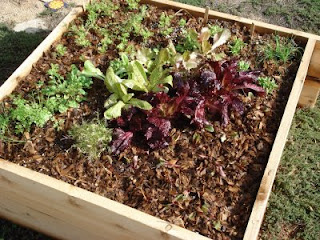
Sowing a Green Movement in Glendale
From the January issue of Verdugo Monthly
Glendale may soon experience a new growth spurt. Not more shopping malls, but vegetables, fruit trees and flowers cropping up on vacant lots. The city — at the urging of mayor John Drayman — is partnering with a fledgling environmental group to plant at least one community garden. “The idea is to have gardens at properties the city isn’t using,” says Drayman, “And to provide a place where people — especially in highly populated areas with many multi-family dwellings — can walk to, and plant flowers, fruit trees, produce.”
The test case is an 11,000-square-foot vacant lot on Monterey Road, next to the Glendale Avenue off-ramp of the 134 freeway. On a recent morning, 22-year-old Alek Bartrosouf scoops up a crumpled soda can from the barren earth. “This is a house lot, abandoned since 1976. It’s owned by the city. Every now and then city employees clean out the weeds and the trash.”
A brick wall and a few palm trees are all that separate the lot from the hissing freeway. If all goes according to plan, this pocket of blight could become a verdant refuge: 20 or so neighbors would claim plots; others would be invited to workshops on gardening, water conservation and composting. The community garden would also feature a tool shed, fruit trees, and a demonstration garden displaying native and Mediterranean plants, watered with drip irrigation.
A floral perfume and the sweet-spicy aroma of sage might help to mask the gritty, metallic freeway smell. Other natives, such as California lilac and the red-berried toyon bush, would likely attract birds, butterflies and bees.
Bartrosouf sees it as a place to nurture environmental awareness: “What a community garden does, is it gets people together. They get to grow their own food, which is environmentally friendly. We won’t use pesticides. We’re also hoping to have a pergola that’s solar-powered, to feed power back to the grid.”
Bartrosouf grew up in Glendale, and credits a teacher at Clark Magnet High School in La Crescenta with sparking his interest in environmental issues. After graduating from UC Santa Cruz, he returned home. “The first thing I noticed,” he recalls, “is there are no recycle bins in public areas. In Santa Cruz there are.”Despite his passion for the environment, Bartrosouf looks more Glendale than Santa Cruz. He’s clean-cut, not pierced or tattooed, and — with the exception of a small turquoise bracelet — dresses fairly conservatively. “I know when to be professional,” he says.
Two years ago, Bartrosouf reconnected with childhood friend Ana Khachatrian, a recent USC graduate. Through a friend, they met another Glendale native of Armenian descent, Garen Nadir. The three were impressed by how other Southland cities, such as Santa Monica and West Hollywood, were responding to environmental problems, and decided Glendale needed a green push from the grassroots. So they launched Coalition for a Green Glendale.
While trolling around the city’s web site, they learned about its Adopt-a-Block program. When they inquired about it, a city staffer suggested they start a garden. Bartrosouf, Khachatrian and Nadir didn’t have green thumbs, but they saw the opportunity to provide environmental education, especially on water conservation. So they signed on and dubbed the project an “eco-community garden.”
One day when the trio was handing out reusable shopping bags at the Montrose Harvest Market, they met landscape architect Guillaume Lemoine. The middle-aged French émigré became their fourth member and designer of the Monterey Road community garden.
Green Glendale and the city hope to make the place ready for gardeners in April or May. Fifteen people have already applied for plots. Among them is 81-year-old Beatrice Crain. “I’m interested because I love plants,” she says in Spanish. “In my house, my plants are my children.” Crain lives in an apartment. Her actual son, Raphael Cardona, says she has small potted plants on each of the 14 steps outside her home, but: “She’s running out of space. The landlord told her, ‘you really can’t have all these in an apartment.’ So she’s looking for a piece of land where she can freely grow a few tomatoes, some flowers...” “I have some seeds,” she beams, “Some very special peach seeds.”
The elderly and children are likely to be the biggest beneficiaries of the eco-community garden, says Glen Dake, board member of the Los Angeles Community Garden Council. “[They] have a place to go. Elderly gardeners develop a better social network. Kids have a place to make mud pies. Among children, it develops stewardship — digging in the dirt, seeing bugs, eating vegetables that they see growing.”
The garden might also improve the participants’ health: A study of a community garden in Pacoima found gardeners there ate more fruits and vegetables than neighbors who didn’t grow food.
Coalition for a Green Glendale wants to raise $50,000 — in cash and, especially, donated materials — for the project. So far the group has secured only a $5,000 grant, but it expects the city to contribute another $5,000 or more. If they fall short, Green Glendale could scale back plans and get started for far less, says LA Community Garden Council’s Glen Dake. Still, it’s a big project for a group of four volunteers.
City managers are eager for Green Glendale to build more community gardens. They’re already proposing a site on Geneva Street. “We’re getting a lot of support from the city,” says co-founder Bartrosouf, “Most people we’ve spoken with are encouraging for our coalition to get out there and do the work.”
To learn more or get involved visit Green-Glendale.org or lagardencouncil.org





















